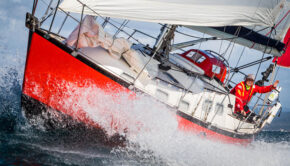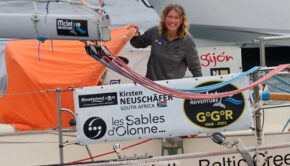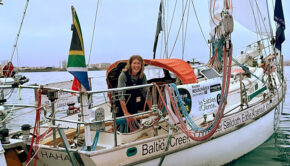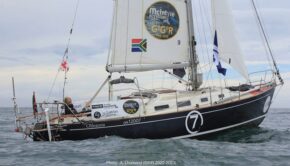Golden Globe Race lifesaving regulations
Published on December 1st, 2022
Before the start, fulfilling the safety and qualifying requirements for the 2022-23 Golden Globe Race were a major hurdle. However, it was these unique regulations which played an important part in saving Tapio Lehtinen following the sinking of his yacht off South Africa.
When Lehtinen woke to a loud bang, he stepped into knee deep water with more flooding like a river from the engine compartment. With no time to think, he prepared the Plastimo “special edition” GGR life raft in the cockpit and donned his dry survival suit, grabbing the small GGR communications emergency grab bag on the way out.
With the raft inflated beside the boat, the securing line he had re-set with a slip knot had let go. When it began drifting away, he could not go below for the main grab bag, as water was above waist height and the decks were awash, so he jumped for the raft now three metres from the boat.
He had also been unable to reach his EPIRB inside the boat, which later automatically water activated, sending the first DISTRESS alert. But it went down with the yacht 20 minutes later taking his two other emergency beacons with it.
Fortunately, GGR safety regulations require a PLB distress beacon and waterproof VHF handheld radio with GPS to be packed inside the raft. In the shock of the moment, he forgot the PLB was in the raft, finding it nearly two hours later and turned it on. At that point it was his only distress beacon.
Inside the GGR comms grab bag, his spare satellite phone was damaged while boarding the raft. (His main sat phone stored at the chart table went down with the ship). Also, inside was the backup waterproof YB3 satellite tracker and texting unit.
GGR control, on learning of the EPIRB Distress and noting ASTERIA’s onboard Tracker was no longer transmitting, assumed the boat had sunk and that Lehtinen was probably in the raft. GGR remotely activated the backup YB3 and noted it had been powered on. This was exciting news, and a message was sent “Are You OK?”
Lehtinen responded shortly after that he was in the raft, all was well but Asteria had sunk. This then gave a second position of the raft that was linked to the GGR 24hr online tracking page for all to see. Using the same YB3 unit, Lehtinen was able to send and receive short messages from the raft, a great comfort for him as a survivor, his family and all his followers around the world. His rescue was a success.
“I know from experience over the past 30 years that when all goes wrong you may not get your grab bag, so what’s in the raft is all you may have,” noted race organizer Don McIntyre. “I always pack a distress beacon in my rafts and now a VHF/GPS, so I made it mandatory for GGR too.
“I also lost a good friend deep in the Southern Ocean in the 1994 BOC challenge when his 48hr EPIRB battery ran out before the ship arrived. We now insist on the YB3 unit in the GGR comms grab bag which tracks every 15 minutes for months, including two-way texting. Tapio was happy to have both.”
It is a long-held tradition of the sea, that if a mariner is in Distress and declares a “Mayday”, all other mariners will use their best endeavors to immediately assist if they are safely able to do so. Such was the case for Abhilash Tomy (IND) on Bayanat and Kirsten Neuschäfer (RSA) on Minnehaha when asked by GGR control to assist in the rescue of fellow GGR entrant Tapio Lehtinen on ASTERIA.
Both altered courses immediately and stopped racing on receiving the request. The rescue was successful, and to calculate time compensation for both sailors, all the facts affecting both sailors were considered, focusing on the primary impacts of:
• Time away from the course
• Changing and new weather systems on resuming the course.
• Position at the start and finish of their diversion.
Based on the information the following time compensation has been determined:
• Kirsten Neuschäfer: 35 hours + 30 litres of fuel
• Abhilash Tomy: 12hrs
Event details – Entry list – Tracker – Facebook
2022 GGR competitors:
Abhilash Tomy (43) / India / Rustler 36
Arnaud Gaist (50) / France / BARBICAN 33 MKII (long keel version)
Elliott Smith (27) / USA / Gale Force 34
Ertan Beskardes (60) / UK / Rustler 36
Guy Waites (54) / UK / Tradewind 35
Ian Herbert Jones (52) / UK / Tradewind 35
Jeremy Bagshaw (59) / South Africa / OE32
Kirsten Neuschäfer (39) / South Africa / Cape George 36
Michael Guggenberger (44) / Austria / Biscay 36
Simon Curwen (63) / UK / Biscay 36
Retired
Edward Walentynowicz (68) / Canada / Rustler 36 (dropped out, Sept. 8)
Guy deBoer (66) / USA / Tashiba 36 (ran aground, Sept. 16)
Mark Sinclair (63) / Australia / Lello 34 (retired in Lanzarote, Sept. 22)
Pat Lawless (66) / Ireland / Saga 36 (retired in Cape Town, Nov. 9)
Damien Guillou (39) / France / Rustler 36 (retired in Cape Town, Nov. 14)
Tapio Lehtinen (64) / Finland / Gaia 36 Masthead sloop (sank off Cape Town, Nov. 18)
About the 2022 Golden Globe Race
On September 4, 2022, the third edition of the Golden Globe Race started from Les Sables d’Olonne, France. Sixteen skippers will face eight months of isolation sailing 30,000 miles across five oceans solo non-stop and unassisted.
In 1968, while man was preparing to take his first steps on the moon, a mild mannered and modest young man was setting out on his own record breaking voyage of discovery. He had entered the original Golden Globe. Nine men started that first solo non-stop sailing race around the World. Only one finished. He was 29 year old Sir Robin Knox Johnston. History was made. Navigating only with a sextant, paper charts and an accurate and reliable time piece, Sir Robin navigated around the world.
In 2018, to celebrate 50 years since that first record breaking achievement, the Golden Globe Race was resurrected. It instantly gained traction with adventurers, captivated by the spirit and opportunity. Eighteen started with five finishers.
To embrace the original race, competitors must sail in production boats between 32 and 36 feet overall and designed prior to 1988 that have a full-length keel with rudder attached to their trailing edge. Additionally, sailors have limited communication equipment and can use only sextants, paper charts, wind up clocks, and cassette tapes for music.
Source: GGR









 We’ll keep your information safe.
We’ll keep your information safe.